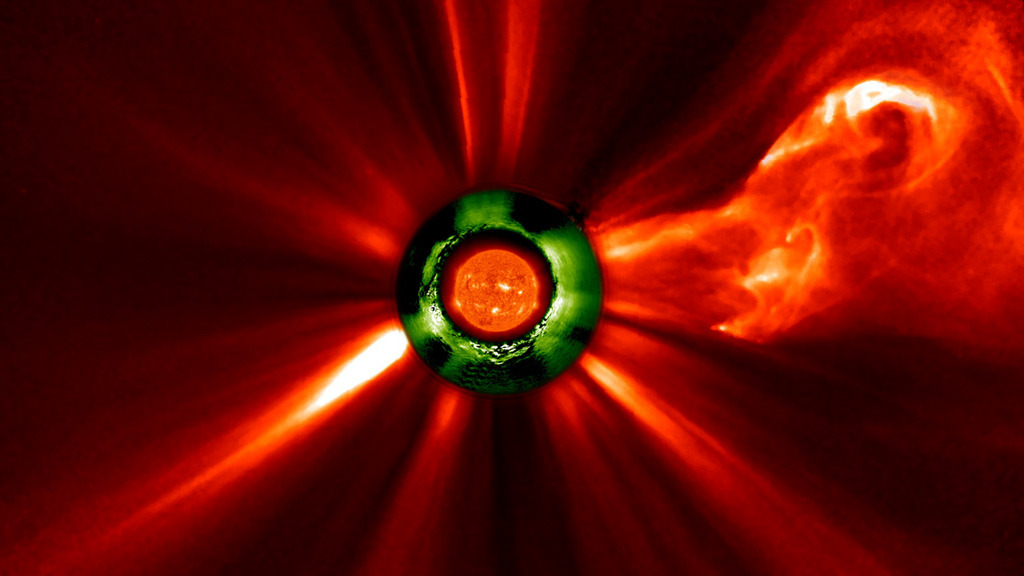NASA's Heliophysics Fleet Captures May 1, 2013 Prominence Eruption and CME
On May 1, 2013, NASA's Solar Dynamics Observatory (SDO) watched as an active region just around the East limb (left edge) of the sun erupted with a huge cloud of solar material—a heated, charged gas called plasma. This eruption, called a coronal mass ejection, or CME, sent the plasma streaming out through the solar system. Viewing the sun in the extreme ultraviolet wavelength of 304 angstroms, SDO provided a beautiful view of the initial arc as it left the solar surface.
Such eruptions soon leave SDO's field of view, but other satellites in NASA's Heliophysics fleet can pick them up, tracking such space weather to determine if they are headed toward Earth or spacecraft near other planets. With advance warning, many space assets can be put into safe mode and protect themselves from the effects of such particle radiation.
In addition to the images captured by SDO, the May 1, 2013 CME was also observed by the ESA/NASA Solar and Heliospheric Observatory (SOHO). SOHO houses two overlapping coronagraphs—telescopes where the bright sun is blocked by a disk so it doesn't overpower the fainter solar atmosphere—and they both saw the CME continue outward. The LASCO C2 coronagraph shows the region out to about 2.5 million miles. The LASCO C3 coronagraph expands even farther out to around 13.5 million miles. Both of these instruments show the CME as it expands and becomes fainter on its trip away from the sun.
NASA's Solar Terrestrial Relations Observatory (STEREO) Ahead satellite saw the eruption from a very different angle. It, along with its twin STEREO Behind, is orbiting at a similar distance as Earth. STEREO-A orbits slightly faster than Earth and STEREO-B orbits slightly slower. Currently, STEREO-A is more than two-thirds of the way to being directly behind the sun, and has a view of the far side of the sun. From this perspective, the CME came off the right side of the sun. STEREO has an extreme ultraviolet camera similar to SDO's, but it also has coronagraphs like SOHO. As a result, using its two inner coronagraphs, it was able to track the CME from the solar surface out to 6.3 million miles.
Working together, such missions provide excellent coverage of a wide variety of solar events, a wealth of scientific data—and lots of beautiful imagery.
Watch this video on YouTube.
Several missions within NASA's Heliophysics System Observatory captured images of a gigantic eruption on the sun on May 1, 2013. Working together, such missions provide excellent coverage of a wide variety of solar events, a wealth of scientific data—and lots of beautiful imagery.
For complete transcript, click here.

Lighten blended combination of SDO AIA 304 and 171 wavelength 4k images.
Credit: NASA's Goddard Space Flight Center/SDO/AIA

Overlay blended combination of SDO AIA 304 and 171 wavelength 4k images.
Credit: NASA's Goddard Space Flight Center/SDO/AIA
Full 4k resolution SDO AIA 304 footage of prominence eruption.
Credit: NASA/SDO/AIA
SOHO LASCO C2 footage covering April 30 to May 1, 2013.
Credit: SOHO/ESA&NASA
SOHO LASCO C3 footage covering April 30 to May 1, 2013.
Credit: SOHO/ESA&NASA
STEREO Ahead EUV 304 angstrom footage of May 1, 2013.

Additional STEREO Ahead still showing eruption on May 1, 2013.
STEREO Ahead Cor1 coronagraph view covering all of May 1, 2013.
STEREO Ahead Cor2 coronagraph view of May 1, 2013.
Credits
Please give credit for this item to:
NASA's Goddard Space Flight Center. However, individual items should be credited as indicated above.
-
Animators
- Scott Wiessinger (USRA)
- Tom Bridgman (Global Science and Technology, Inc.)
-
Video editor
- Scott Wiessinger (USRA)
-
Producer
- Scott Wiessinger (USRA)
-
Writers
- Scott Wiessinger (USRA)
- Karen Fox (ADNET Systems, Inc.)
Series
This page can be found in the following series:Tapes
The media on this page originally appeared on the following tapes:-
Helio Fleet View of May 1 Prominence Eruption
(ID: 2013048)
Tuesday, May 7, 2013 at 4:00AM
Produced by - Robert Crippen (NASA)
Datasets used
-
[SOHO]
ID: 93SOHO monitors the Sun with a variety of instruments. Among the SOHO instruments is the Michelson Doppler Interferometer (MDI) and the Extreme ultraviolet Imaging Telescope (EIT).
This dataset can be found at: http://sohowww.nascom.nasa.gov
See all pages that use this dataset -
LASCO/C2 (C2) [SOHO: Large Angle Spectrometric COronagraph (LASCO)]
ID: 160This dataset can be found at: http://sohowww.nascom.nasa.gov
See all pages that use this dataset -
LASCO/C3 (C3) [SOHO: Large Angle Spectrometric COronagraph (LASCO)]
ID: 161This dataset can be found at: http://sohowww.nascom.nasa.gov
See all pages that use this dataset -
[SDO]
ID: 168This dataset can be found at: http://sdo.gsfc.nasa.gov/
See all pages that use this dataset -
[STEREO]
ID: 169The STEREO mission consists of two Sun-observing spacecraft that will travel around the Sun on orbits slightly inside and slightly outside Earth's orbit.
This dataset can be found at: https://stereo.gsfc.nasa.gov
See all pages that use this dataset -
[STEREO-A: Extreme UltraViolet Imager (EUVI)]
ID: 185This dataset can be found at: https://stereo.gsfc.nasa.gov
See all pages that use this dataset -
[STEREO-A: Coronograph 1 (COR1)]
ID: 186This dataset can be found at: https://stereo.gsfc.nasa.gov
See all pages that use this dataset -
[STEREO-A: Coronograph 2 (COR2)]
ID: 187This dataset can be found at: https://stereo.gsfc.nasa.gov
See all pages that use this dataset -
AIA 304 (304 Filter) [SDO: AIA]
ID: 677This dataset can be found at: http://jsoc.stanford.edu/
See all pages that use this dataset
Note: While we identify the data sets used on this page, we do not store any further details, nor the data sets themselves on our site.
Release date
This page was originally published on Tuesday, May 7, 2013.
This page was last updated on Wednesday, May 3, 2023 at 1:52 PM EDT.

![Complete transcript available.Music credits: ‘Electricity Wave’ by Jean-François Berger [SACEM] and ‘Solar Winds’ by Ben Niblett [PRS], Jon Cotton [PRS]Watch this video on the NASA Goddard YouTube channel.](/vis/a010000/a012600/a012693/LARGE_MP4-12693_FirstCMEDuringEclipse_large.00139_print.jpg)